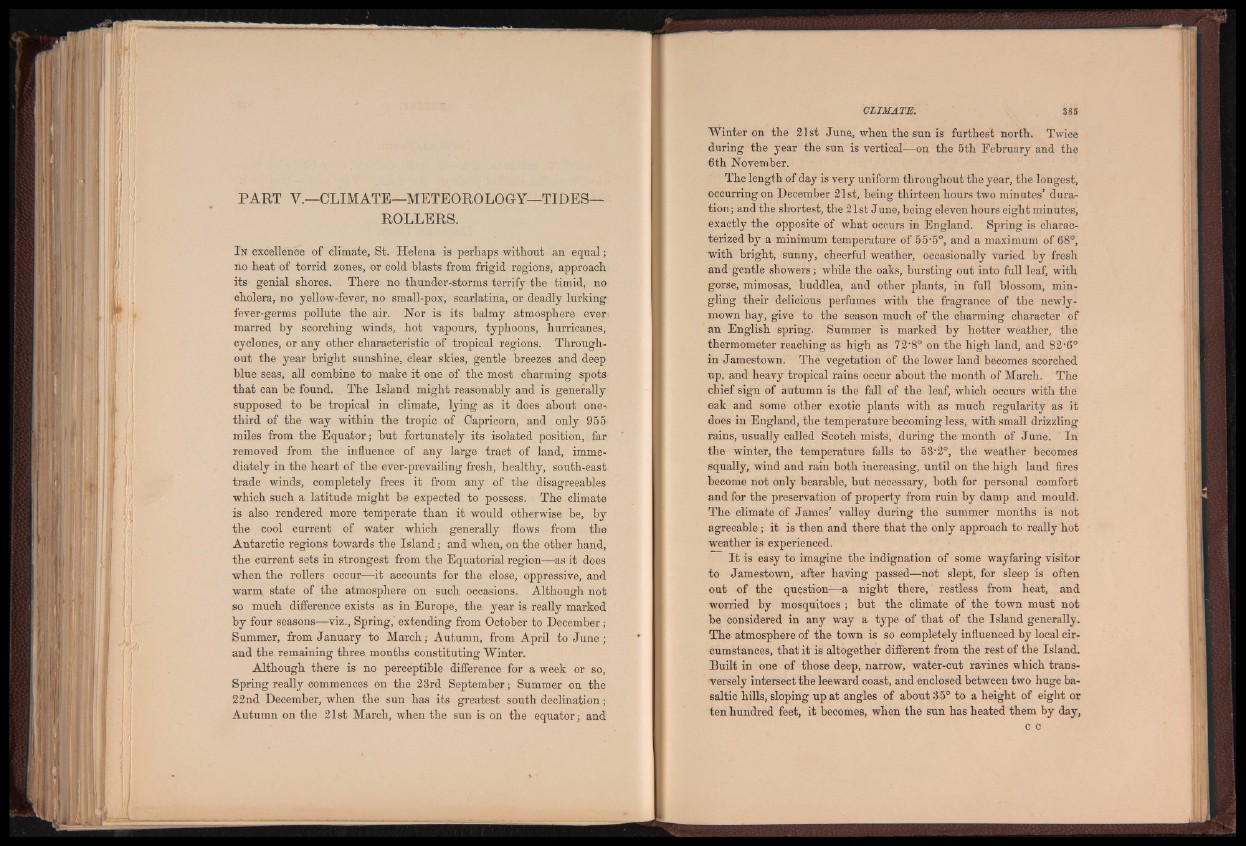
PART V.—CLIMATE—METEOROLOGY—TIDES—
ROLLERS.
I n excellence of climate, St. Helena is perhaps without an equal;
no heat of torrid zones, or cold blasts from frigid regions, approach
its genial shores. There no thunder-storms terrify the timid, no
cholera, no yellow-fever, no small-pox, scarlatina, or deadly lurking
fever-germs pollute the air. Nor is its balmy atmosphere ever;
marred by scorching winds, hot vapours, typhoons, hurricanes,
cyclones, or any other characteristic of tropical regions. Throughout
the year bright sunshine, clear skies, gentle breezes and deep
blue seas, all combine to make it one of the most charming spots
that can be found. The Island might reasonably and is generally
supposed to be tropical in climate, lying as it does about one-
third of the way within the tropic of Capricorn, and only 955
miles from the Equator; but fortunately its isolated position, far
removed from the influence of any large tract of land, immediately
in the heart of the ever-prevailing fresh, healthy, south-east
trade winds, completely frees it from any of the disagreeables
which such a latitude might be expected to possess. The climate
is also rendered more temperate than it would otherwise be, by
the cool current of water which generally flows from the
Antarctic regions towards the Island; and when, on the other hand,
the current sets in strongest from the Equatorial region—as it does
when the rollers occur—it accounts for the close, oppressive, and
warm, state of the atmosphere on such occasions. Although not
so much difference exists as in Europe, the. year is really marked
by four seasons—viz., Spring,’ extending from October to December;
Summer, from January to March; Autumn, from April to June ;
and the remaining three, months constituting Winter.
Although there is no perceptible difference for a week or so,
Spring really commences on the 23rd September; Summer on the
22nd December, when the sun has its greatest south declination;
Autumn on the 21st March, when the sun is on the equator; and
Winter on the 21st June, when the sun is furthest north. Twice
during the year the sun is vertical—on the 5th February and the
6th November.
The length of day is very uniform throughout the year, the longest,
occurring on December 21st, being thirteen hours two minutes’ duration;
and the shortest, the 21st June, being eleven hours eight minutes,
exactly the opposite of what occurs in England. Spring is characterized
by a minimum temperature of 55'5°, and a maximum of 68°,
with bright, sunny, cheerful weather, occasionally varied by fresh
and gentle showers; while the oaks, bursting out into full leaf, with
gorse, mimosas, buddlea, and other plants, in full blossom, mingling
their delicious perfumes with the fragrance of the newly-
mown hay, give to the season much of the charming character of
an English spring. Summer is marked by hotter weather, the
thermometer reaching as high as 72'8° on the high land, and 82'6°
in Jamestown. The vegetation of the lower land becomes scorched
up, and heavy tropical rains occur about the month of March. The
chief sign of autumn is the fall of the leaf, which occurs with the
oak and some other exotic plants with as much regularity as it
does in England, the temperature becoming less, with small drizzling
rains, usually called Scotch mists, during the month of June. In
the winter, the temperature falls to 53'2°, the weather becomes
squally, wind and rain both increasing, until on the high land fires
become not only bearable, but necessary, both for personal comfort
and for the preservation of property from ruin by damp and mould.
The climate of James’ valley during the summer months is not
agreeable; it is then and there that the only approach to really hot
weather is experienced.
I t is easy to imagine the indignation of some wayfaring visitor
to Jamestown, after having passed—not slept, for sleep is often
out of the question-—a night there, restless from heat, and
worried by mosquitoes ; but the climate of the town must not
be considered in any way a type of that of the Island generally.
The atmosphere of the town is so completely influenced by local circumstances,
that it is altogether different from the rest of the Island.
Built in one of those deep, narrow, water-cut ravines which transversely
intersect the leeward coast, and enclosed between two huge basaltic
hills, sloping up at angles of about 35° to a height of eight or
ten hundred feet, it becomes, when the sun has heated them by day,